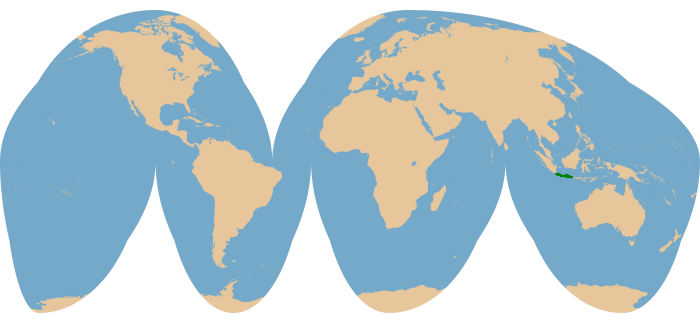Kingdom: |
Animalia Chordata Mammalia Artiodactyla Ruminantia Tragulidae Tragulus |
Common name:
Scientific name:
Other names: |
Javan chevrotain
Tragulus javanicus
Javan mousedeer |
Physical Characteristics
- Head and body length:
40-45 cm
- Shoulder height: 25-30 cm
- Tail length: 9 cm
- Adult weight: Approximately 2 kg
- Shoulder height: 25-30 cm
Very similar to the lesser Malayan chevrotain (Tragulus kanchil), the Javan chevrotain is one of the smallest ungulates, with a rounded back and very slender legs. The general color of the short pelage is reddish-brown, with the head and back being darker than the flanks. The neck may be reddish like the body with a distinct black stripe on the nape (as described for T.j. pelandoc) or gray with no nape stripe (T.j. focalinus) - however, the taxonomic validity of these forms has not been ascertained, and a range of intermediates has been described. The underparts, including the underside of the tail, are white, and there is a narrow orange stripe down the center of the belly. Like the lesser Malayan chevrotain (Tragulus kanchil), three white stripes radiate from the white underside of the chin onto the throat. Adult males develop long upper canine teeth which may be several centimeters long and protrude past the upper lip.
- Similar species
- The lesser Malayan chevrotain (Tragulus kanchil) closely resembles the Javan chevrotain in size, coloration, and markings. Range is the most definitive identifier, although gray-necked chevrotains appear to be restricted to Java.
Reproduction and Development
- Gestation period:
132-134 days.
- Litter size: One, although twins are known.
- Sexual maturity: Females as young as 126 days (4 months); males at 167 days (4.5 months).
Little is known regarding reproduction in this species. Births from captive animals in Java have been reported in March, April, May, July, and December, suggesting that the species breeds throughout the year. Young begin to nibble on solid food at a very young age. Other aspects of reproductive biology are likely similar to the lesser Malayan chevrotain (T. kanchil).
Ecology and Behavior
- Family group:
Solitary, occasionally seen in groups of two.
- Diet: Fruit, as well as leaves and shoots.
- Main Predators: Most medium to large predators, including the Javan hawk-eagle, jungle cat, civets, mongooses, dhole, leopard, and (formerly) Javan tiger.
- Diet: Fruit, as well as leaves and shoots.
Habitat and Distribution

Conservation Status
- IUCN Red List:
Data Deficient (2015).
- CITES Listing: Not listed (2019).
- Threats: Habitat loss and fragmentation, hunting.
- CITES Listing: Not listed (2019).
The Javan chevrotain is currently encountered primarily in protected areas, and it has been suggested that the species may be sensitive to human disturbance. No population estimates have been made, and the question of taxonomy (how many species are present) further confounds assessing the status in the wild. Given the limited (and shrinking) habitat available on Java and high human pressures, chevrotains on Java are likely to be declining.
